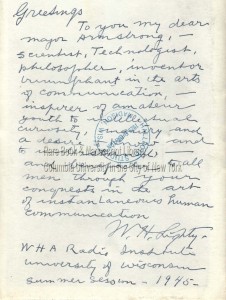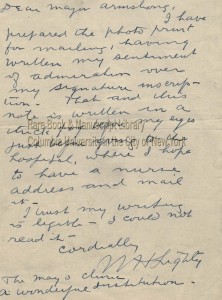 |
This significant and historically rich collection has been open for use here now for many years. To any who may have searched within it, this will come as some welcome news: thanks to the Armstrong Memorial Research Foundation and generous grants from the IEEE Foundation, the IEEE Communications Society, the IEEE Circuits and Systems Society, Alcatel-Lucent Foundation, Columbia University’s Department of Electrical Engineering, and Fu Foundation School of Engineering and Applied Science, I have been charged with re-processing this collection with the goal of increasing accessibility through the provision of a more descriptive aid.
This blog will highlight just a sliver of this incredible collection. I have been blessed with the luxury of hiring a graduate student, Jen Howard (EE GS ’10), who will be sharing these finds as well (expect forthcoming posts from her!). She is studying for her masters in electrical engineering here, which when contrasted with my humanities background, will serve to provide a broader and hopefully, a more interesting and varied perspective.
On the Title…
By now, you have noticed the letter up on your left—While debating the title of this blog Jen, who has been given the task of researching and describing the photographs, came upon the one shown below of Major Armstrong and William H. Lighty. She pointed out the accompanying letter which we both agreed was perfect—“scientist, technologist, philosopher, inventor triumphant in the arts of communication”.
 |
The awe and inspiration Lighty expressed in this letter permeated the entire scientific community from the time of Howard’s first creation, the regenerative circuit in 1912 to his complete Frequency Modulation system, in 1933.
 |
Edwin Howard Armstrong (known to his friends as Major) is credited with a multitude of inventions in the radio communications field. He secured 42 patents throughout his career, of which the most well known are the regenerative circuit, superheterodyne circuit in 1918, the superregenerative circuit in 1922, and his commercially viable FM Radio system.
Armstrong was of a stubborn character, refusing to follow the accepted mathematical theories of the time. His persistence and systematic method of experimentation produced discoveries that would turn accepted dogma on its head. His creative genius ushered mankind into a new world and his inventions remain the mainstay of wireless communications today.
An invitation…
It is our hope that this blog will serve as not only a place where we can post our finds, but in addition, serve as an informal exchange of information, inspiration, and opinions on this creative genius who was once known as a fixture here at Columbia. He was usually found toiling away in the Marcellus Hartley Laboratory located in the basement of Philosophy Hall. He forms not only a fundamental part of American History, but also a salient part of Columbia University’s history and its renowned engineering school (www.ee.columbia.edu/pages/deptoverview/index.html).
I wish to invite and encourage students, faculty, staff, electrical engineers, young radio enthusiasts and historians of Radio History, to post here and pass this site around. Let’s increase interest in this historically rich collection, and the overlooked importance of Armstrong’s role in revolutionizing radio communications.
More posts to follow!
(From first picture caption)
Lighty worked in the field of adult education serving on the administrative staff of the Extension Division and first program manager of Station WHA. His primary influence was the use of radio broadcast as an educational medium. WHA is today considered the most successful model of educational radio in broadcasting history.
www.wisconsinhistory.org/wcftr
www.wisconsinhistory.org/libraryarchives/
Thank you so much for the important work you are doing to properly archive the papers of my ancestor, Edwin Howard Armstong (or Uncle Howard as he is known in the family). Your extraordinary dedication and care are vastly appreciated — as are the efforts and generosity of those who made your important project possible.
In gratitude,
Adam Brecht
Dear Mr. Schwartz and Ms. Comins,
I was delighted to read the story in today’s NYTimes. I was the writer/director of the radio version of “Empire of the Air,” to which your blog directs folks. Tom Lewis’ book was the source material, but it was Major Armstrong’s tragedy that overtook the Saga of Radio for both of us. It was a terrific production, with David Ogden Stiers as Armstrong and Bonnie Bedelia as his wife, the late John Randolph as deForest (whom I actually met!) and an icy Harris Yulen as Sarnoff. My wife, the producer Judith Walcutt, has always seen it as a play for stage. Perhaps your discoveries will make that possible. Regards, David Ossman
My first acquaintance with Major Armstrong’s name was through attending the Signal School at Ft Monmouth, NJ; and later by attending many an educational course in the building named for him at Ft Monmouth where I was employed as an engineer for 30 years. As a youth I made my own crystal radio set, followed by a super-regenerative receiver. In my teens I repaired radios that still used the original FM radio band. His life ended tragically on my 22nd birthday.
Thank you for doing this. Consider the importance of the Major in the history of humankind. His creation of FM led not only to FM radio and TV, but cellphones, GPS systems, WiFi and a myriad of other communications devices. And if he, indeed, invented the triode (and it’s likely he did), that was the precursor of the transistor and eventually, the computer microchip. So that means virtually EVERY important piece of technology in our world today has a connection to an Armstrong invention.
I became interested as a PhD grad student in EE having bought the Armstrong biography in 1968 “Man of High Fidelity” and reading the sponsored biography of Sarnoff about that time. When I returned to academia , becoming a professor at Brown, and had the chance to teach a large class on circuits, I started a Friday “story time” in which I told the story of the two men. Have been doing this for some 20 years now. Recently was asked to write an article on it for IEEE Signal Processing Magazine. Even have some original stuff from my next office professor — Barrett Hazeltine whose father was a strong Armstrong supporter. Perhaps someone could help me get copyright releases for a few pictures for the article.
As I wrote in a different post, he was the subject of a book by a Brooklyn College professor in the early-mid 70’s. I remember thinking that it seemed that FM radio had no parent when, in fact, Major Armstrong, as brought to life in the book, proved FM to be no orphan. Sorry but I cannot remember the name of the book or the professor.
This is amazing work. My first job in radio was on an REL FM transmitter in 1965, this being from an offshoot of an Armstrong Company in LI City, NY. I have always been fascinated by his story, and the sadness of the fight with Sarnoff, two men who were once friends. I often wonder what the Major would have invented had he lived on as an inventor. Perhaps he would have figured out digital sampling years before anyone else, or even a better method of FM stereo? I’ll look forward to following this blog carefully and seeing what all comes out. Thanks for this great work.
Let me add my thanks as a researcher who has followed the FM story for more than four decades–ever since my dissertation at the University of Wisconsin back in 1969. You are doing hugely important work that will help to rescue and revive Howard Amstrong’s reputation among future researchers and students of electronic media history. I look forward to seeing the results–and soon.
Armstrong is way overdue for a documented biographical study to replace the earnest but really very limited Lessing work (MAN OF HIGH FIDELITY) first published in 1956 and slightly updated in a 1969 paperback–both are collectibles. Indeed, the number of books about FM (merely the best known of Armstrong’s many inventions) is amazingly limited given that Armstrong’s system now dominates radio, just as he said it would. Michael Keith and I wrote SOUNDS OF CHANGE: A HISTORY OF FM BROADCASTING IN AMERICA (U, of North Carolina Press, 2008) to place some of the medium’s history on record. More work is needed….especially about the man who started it all, and who clearly deserves extended treatment.
Thank you for doing this. Armstrong is something of a hero to us at the InfoAge site in Wall Township, New Jersey (formerly the Marconi Belmar receiving station, and also formerly the US Army Signal Corps’ Camp Evans) and we are pleased to see that he may finally be getting his due.
On January 31, 1914, Armstrong used the antennas of the under-construction Marconi station at Belmar, NJ to demonstrate his regen receiver to a certain David Sarnoff and other members of the American Marconi Company’s staff. Needless to say, they were extremely impressed and after the formation of RCA in 1919 and the ascendancy of David Sarnoff, RCA purchased the regen patent and helped make Armstrong a wealthy man. (This of course was prior to the Armstrong/Sarnoff falling out).
Armstrong has at least one other connection with our site. In January of 1946, after the Second World War, the Army Signal Corps performed here the first “moonbounce” experiments which proved that radio communication through space was possible. While Dr. Walter McAfee and others contributed much to this success, so did Armstrong – he designed the receiving equipment. And let us not forget that Armstrong conceived the superhet idea when he was in the Army Signal Corps in France during World War I, nor should we forget that Armstrong’s FM invention, when applied to military radio in World War II, contributed significantly to making the US’s communications links far more robust than those of our enemies in that conflict.
So yes, Armstrong has been overlooked for far too long.
Thanks so much for this critical work.
Pretty much has been said via the comments above, but I think that it is a common sentiment that Major Armstrong suffered unjustly throughout his life, and that the work that he did in radio dwarfs that done by everyone else.
My two copies of “Man of High Fidelity” are dog-eared and yellowed, but remain a great source of inspiration. Does the world still produce giants such as the Major?
Thanks for putting up this wonderful blog. I have bookmarked it right away.
Your blog looks great. Looking forward to more insightful posts. Thank you.
It’s great to learn there’s a blog like this serve as database of resources and information exchange. Thank you for putting all the valuable material for readers.
Hope I’m not too late to discover this great blog. I’m your newest reader.
Hi, Jen,
It was a pleasure meeting you at our Armstrong 75th Anniversary event at Alpine on Saturday the 6th. I applaud what you are doing at Columbia to help to bring all of the Major’s history and legacy out in the open, so that it will be even more accessible to both the general public and independent researchers.
There are very few people today who realize the enormous contributions of Major Armstrong, and how his work has changed and influenced their daily lives.
Every time you turn on a radio, a TV set , or a cellular telephone, you are both enjoying and benefitting from the results of the Major’s life’s work.
Thank you so much for what you are doing! Hope to meet with you again soon!
Very best regards,
Steve Hemphill
WA2XMN Licensee and Alpine Curator
Great blog, I’m subscribing!
What an incredible archive. I hope you enjoy working through Major Armstrong’s works, I’m sure there are many other people who will really appreciate the output.